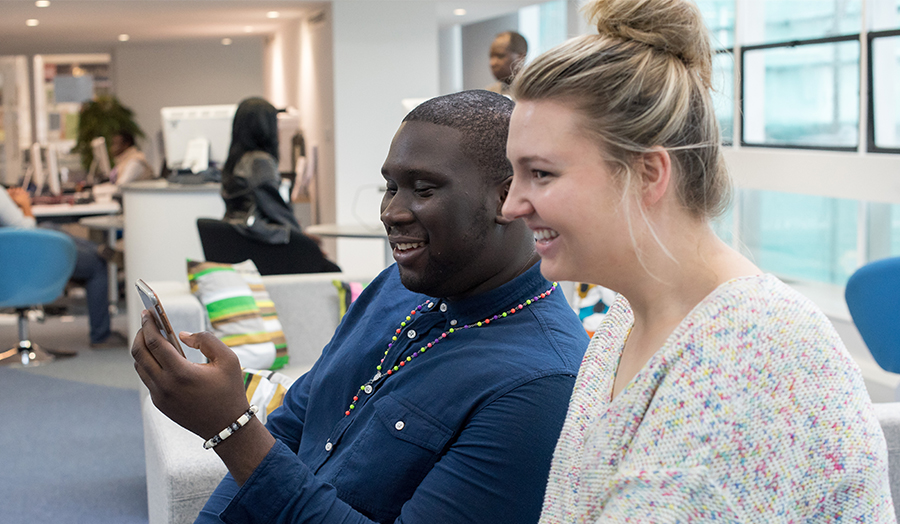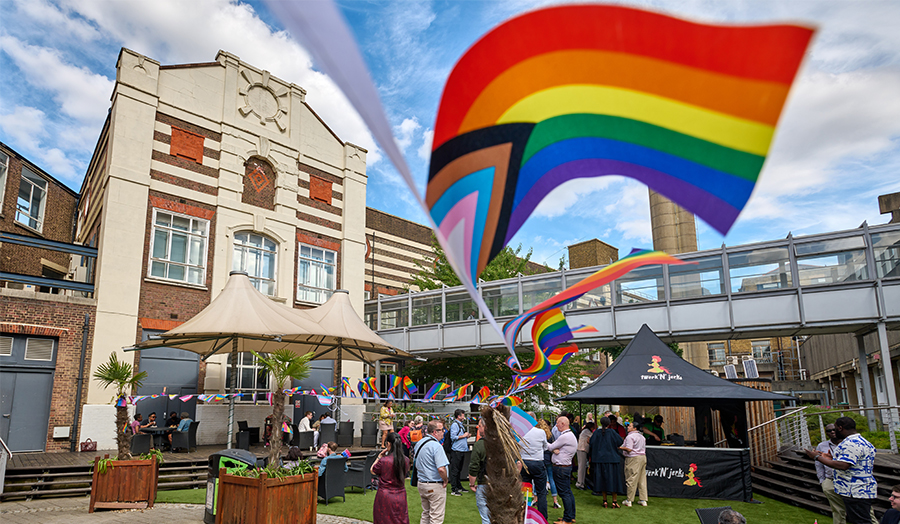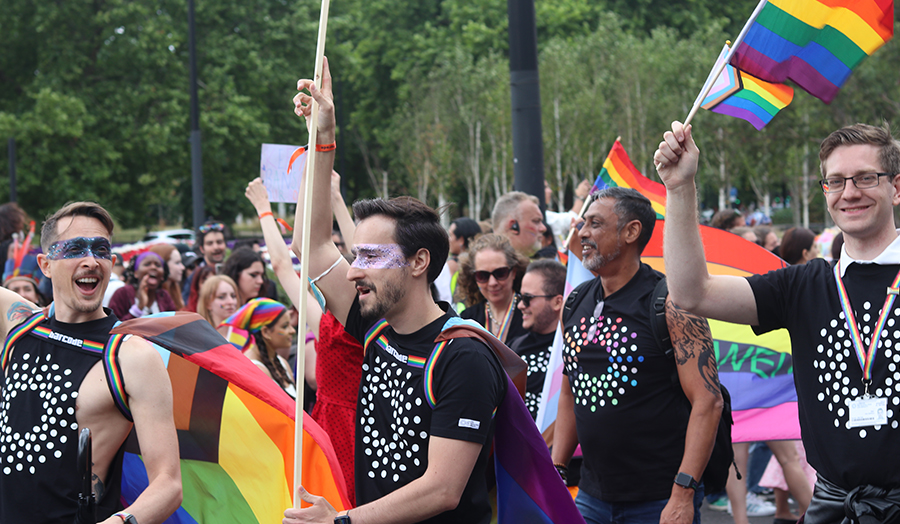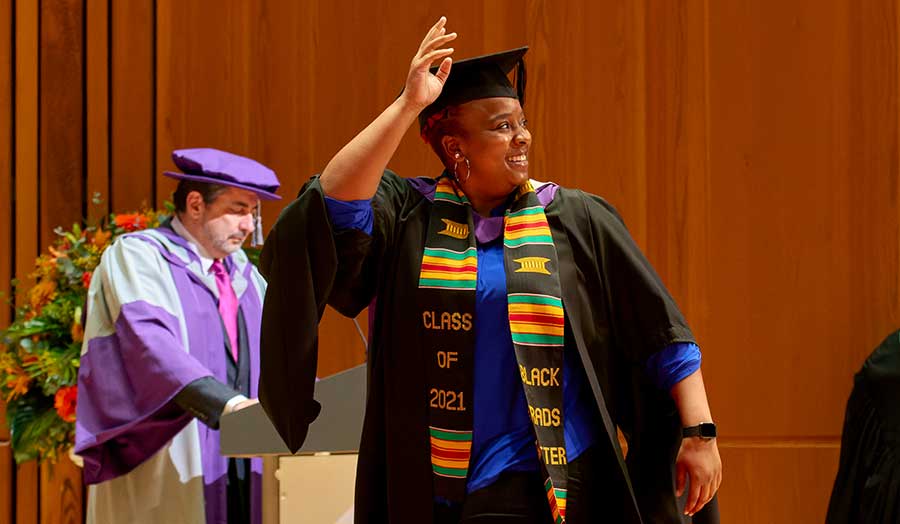We are proud to have a diverse student cohort – over 80% of whom are mature learners.
Tips when considering inclusive language
- Avoid using the terms girls or boys when referring to colleagues or employees, as these refer to children.
- Avoid using language that stereotypes based on age.
| Rather than... | How about? |
|---|---|
| the boys/girls in the office |
our colleagues in the office |
- Avoid ageist terms such as elderly, OAPs, pensioners or youngsters.
| Rather than... | How about? |
|---|---|
|
a young and vibrant team |
- Only if relevant to discussion |

London Met is proud to be a Disability Confident Employer, and we welcome students with disabilities, long-term medical or mental health conditions or Specific Learning Difficulties (SpLDs) such as dyslexia with the help of our Disability and Dyslexia Service (DDS).
The London Met Staff DisAbility Network* is an inclusive network open to all staff members at the University who identify as having a disability.
Under the provisions of the Equality Act (2010), the term “disability” covers a wide scope including individuals with learning differences, mental health conditions, physical conditions, long-term medical conditions, hearing impairments, auditory impairments and neurodivergence, eg ADHD and Autism Spectrum Conditions. Under the Equality Act (2010), a disability is a condition which lasts (or is expected to last) for 12 months or longer with a substantial impact on day-to-day life.
The network aims to provide disabled staff with a safe and confidential space to share experiences, best practice, information and support related to disability.
The aims of the network for 2022 are to enable disabled staff to have a voice in order to shape the development of the University so that it is inclusive for everyone, and to raise a greater awareness of staff with disabilities at the University and the positive skills that they can bring.
Support for staff with disabilities [staff login required]
Support for students with disabilities
Tips when considering inclusive language
- Avoid blanket terms. Try to use names or more specific conditions.
| Rather than... | How about? |
|---|---|
|
the disabled, the handicapped |
person with a disability |
- Avoid using terms that imply normalcy / being healthy when referring to people without disabilities.
| Rather than... | How about? |
|---|---|
|
normal, healthy, able-bodied person |
people without a disability |
-
Use open language, avoiding binaries or descriptors that imply a “norm”
| Rather than... | How about? |
|---|---|
|
disabled toilets / lifts |
accessible toilets / lifts |
- Avoid negative terms that overextend the severity of a disability.
| Rather than... | How about? |
|---|---|
|
wheelchair-bound, confined to a chair cancer or dementia sufferers |
wheelchair users people living with cancer or dementia |
-
Avoid outdated and derogatory terms in any context.
| Rather than... | How about? |
|---|---|
|
crazy, psycho, mad, mental (these words have been used to demonise and ostracise people with mental health conditions) |
outrageous, bananas, bizarre, amazing, intense, extreme, overwhelming or wild (when discussing anything other than mental illness) |
-
Avoid terms that equate the person with the ability or disability.
| Rather than... | How about? |
|---|---|
|
a schizophrenic |
individual with schizophrenia |
-
Avoid using euphemisms.
| Rather than... | How about? |
|---|---|
|
challenged, special |
person with learning difference |
-
Avoid being effusive about the achievements of people with a disability when they are going about their daily life and work.
| Rather than... | How about? |
|---|---|
|
courageous, inspiring, heroic |
- |
While the above is not an exhaustive list of language do’s and don’t's, it does give you an idea on how to talk with people with a disability. Do remember that each person will have different ways that they wish to be referred to, or talk about the disability community in different terms, so please respect individual choice. If in doubt, ask!
* Staff login required

“In the Staff DisAbility Network, we see the language which is used both in our community and by others as being important for shaping the views of ourselves and others. The use of negative or person-second terminology only supports the medical model of disability which, while useful in some cases, only blames the individual for their difficulties. By taking a positive or person-first language stance, we enable the use of the social model of disability which helps to break down the barriers of disabled staff. By highlighting social ‘walls’ in language (and thus wider society) it leads to a more inclusive community”.
Martyn Brown (Staff DisAbility Network Chair)
Inclusive language
At London Met we strive for our language usage to be both deliberate and inclusive. It is important to avoid references to a person’s gender and their sexual orientation except where it is pertinent to the discussion. This often involves seeking gender neutrality when using terms, expressions and pronouns.
The Women’s Network
The Women’s Network* enables all self-defining women staff to come together, share experiences, opportunities and knowledge, offer mutual support, and discuss issues that are important to them. It also seeks to inform the development of University policy and procedures relating to the working lives of women staff.
Athena SWAN
London Met has been awarded an Athena Swan Bronze Award, in recognition of our ongoing commitment to the advancement of gender equality: representation, progression and success for all.
Tips for inclusive language
-
Use gender-neutral pronouns and expressions.
-
Avoid language that emphasises a gender binary.
| Rather than... | How about? |
|---|---|
|
welcome ladies and gentlemen both genders |
welcome everyone all genders |
- Use person-centred language.
| Rather than... | How about? |
|---|---|
|
a transgender |
trans(gender) people/person |
- Use language that validates the transgender experience.
| Rather than... | How about? |
|---|---|
|
female-bodied or male-bodied |
assigned male/female at birth |
-
Introduce yourself and your pronouns to encourage others to do the same – use gender-neutral pronouns unless you know a person’s preferred pronoun(s).
-
Respect people’s pronoun preferences including those people who want to be referred to by gender-neutral pronouns.
| Rather than... | How about? |
|---|---|
|
assuming she, her, hers and he, him, his |
They, them, theirs (eg Courtney ate their food because they were hungry). |
-
Use terms that include all relationships.
| Rather than... | How about? |
|---|---|
|
boyfriend, wife, husband |
partner, spouse |
-
Avoid titles that imply the usual job-holder being of a particular gender.
| Rather than... | How about? |
|---|---|
|
cleaning ladies |
cleaners |
-
Be mindful of appropriate and respectful in-group versus out-group naming, ie avoid using terms that are only used by individuals that self-identify as part of a specific community.
| Rather than... | How about? |
|---|---|
|
queer (only use if you identify as queer) |
LGBTQIA+ community |
-
Avoid gender descriptions when irrelevant.
| Rather than... | How about? |
|---|---|
|
a female scientist |
a scientist |
-
Recognise and respect the difference between sexual orientation and gender identity.
| Rather than... | How about? |
|---|---|
|
using LGBTQIA+ if you are only talking about gender or gender identity |
using LGBTQIA+ only when referring to both sexual orientation and gender identity-based communities |
* Staff login required

Our LGBTQIA+ community
Here at London Met, we're dedicated to ensuring equal opportunities for all, including those who identify as lesbian, gay, bi, trans, queer or another sexual minority.
Our LGBTQIA+ student society
The LGBTQIA+ Society at the University represents our LGBTQIA+ students by working with the Students’ Union to improve the university experience of LGBTQIA+ students through welfare and awareness campaigns on campus as well as by organising a range of great events.
Our LGBTQIA+ staff network
We have an active staff network at London Met, which organises socials, runs a programme of events for LGBTQIA+ History Month and works to create a supportive and safe environment for staff and students across the University.
- Avoid terms that suggest a degree of voluntary choice.
| Rather than... | How about? |
|---|---|
|
sexual preference |
sexual orientation |
-
Use person-centred language.
| Rather than... | How about? |
|---|---|
|
lesbians, gays, bisexuals |
lesbian, gay, bisexual people (it is important to be mindful of how people identify themselves in different ways) |
-
Recognise diverse family formation.
| Rather than... | How about? |
|---|---|
|
mother and father |
parents, caregivers |
-
Recognise and respect the difference between sexual orientation and gender identity.
| Rather than... | How about? |
|---|---|
|
using LGBTQIA+ (if you are only talking about sexual orientation) using straight as the opposite of LGBTQIA+ (transgender people can be any sexual orientation, including straight) |
using LGBTQIA+ when referring to both sexual orientation and gender identity-based communities |
- Avoid outdated terms.
| Rather than... | How about? |
|---|---|
|
homosexuals |
gay |
Queer is sometimes used as an umbrella term to refer to all people with non-heterosexual sexual orientations. Although it is a reclaimed term within the LGBTQIA+ community, it is still considered offensive to many and should not be used.

At London Met, we do not have a seasonal relationship with the race equity agenda. Addressing racial and social justice sits at the heart of our mission. There is no other sector better placed than higher education to address complex social problems, and for too long, equalities rhetoric has not been matched with real action within the walls of the academy.
Race Equity Strategy
London Met’s Race Equity Strategy 2020/21 – 2024/25, developed in consultation with staff and students, reflects our commitment to ensure that we deliver real change across the University. The full scale of our activities is not captured in the plan because our approach is truly holistic; every individual in every department of the University is part of the solution to create the systems and environment where everyone is respected and valued.
Black history – all year round
At London Met Black history is not just a month; we have a commitment to the importance of Black history 365 days of the year. The London Met Black, Asian and Minority Ethnic Voice Network*, in collaboration with all University departments, deliver Black history month 365 events all year round.
Although from time to time, we will have to use the term BAME (Black, Asian and Minority Ethnic) when benchmarking data or externally reporting, we have made the decision to move forward from the term in favour of using the suffix "of Colour", eg people of Colour, staff of Colour.
There will never be a neat acronym that can adequately capture the nuances and cultures of Britain’s minoritised ethnic groups, but we believe this term best conveys the plurality of the individual racialised community experience.
Tips for using inclusive language
-
Use adjectives rather than nouns when it is necessary to refer to someone’s race/ ethnicity.
| Rather than... | How about? |
|---|---|
|
Asians |
Asian people |
-
Avoid irrelevant ethnic descriptions.
| Rather than... | How about? |
|---|---|
|
the Asian doctor |
the doctor |
-
Avoid terms that homogenise lived experiences of different marginalised groups.
| Rather than... | How about? |
|---|---|
|
BAME / BME |
people of Colour |
-
Avoid terms that refer to a nonspecific group label often used in scientific literature to describe subgroups that are too small for meaningful analyses.
| Rather than... | How about? |
|---|---|
|
other |
using a defined and reported category from this group, especially when reporting on racial and ethnic categories. |
-
Avoid language that contributes to the deficit model.
| Rather than... | How about? |
|---|---|
|
Attainment Gap |
Awarding Gap |
-
Avoid outdated and racist terms.
| Rather than... | How about? |
|---|---|
|
Coloured |
POC (People of Colour) |
-
Avoid dehumanising language.
| Rather than... | How about? |
|---|---|
|
illegal immigrant |
undocumented |
* Staff login required

London Met stands opposed to antisemitism and islamophobia. Eliminating racial and religious bias is central to the University's commitment to being an inclusive and welcoming space for all.
In June 2020, the University adopted the working definition of antisemitism as developed by the International Holocaust Remembrance Alliance (IHRA). London Met was the first UK university to adopt the working definition of Islamophobia as developed by the All Party Parliamentary Group (APPG) on British Muslims.
Tips for using inclusive language
Only refer to the person's religion if it relates to the information you are communicating.
- Avoid using Christian-centric terms, not only on grounds of respect but also for practical reasons. The term "last name" should not be used as it could be confusing to certain cultures who place their family name first.
| Rather than... | How about? |
|---|---|
|
Christian name surname |
first name, given name family name |
-
Groups of the same religion/ belief should be referred to as a community.
| Rather than... | How about? |
|---|---|
|
Muslims Jews |
Muslim community Jewish people |

